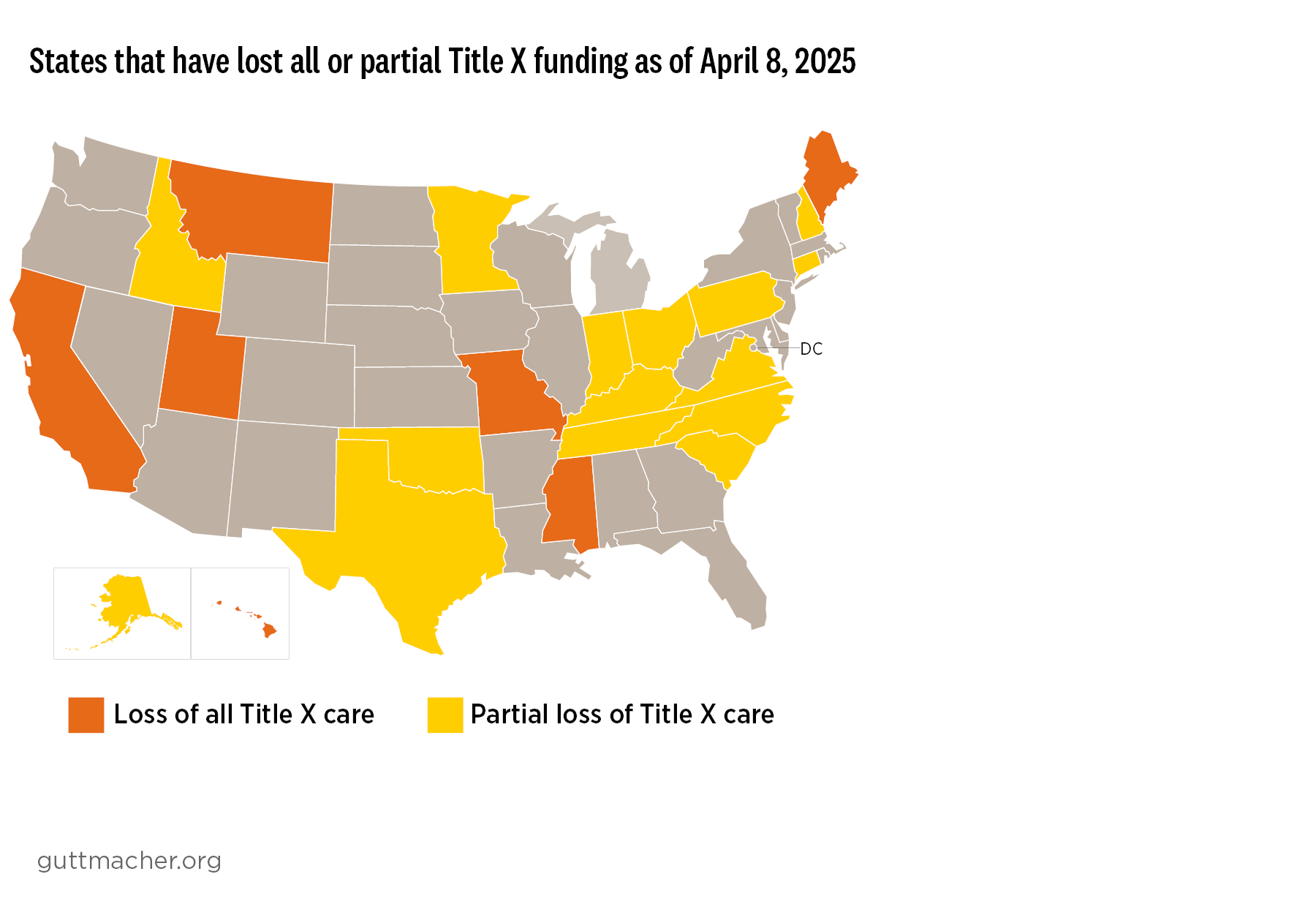Title X is the only federal program in the United States dedicated to providing family planning services to low-income individuals, particularly those who have no insurance or are underinsured.
In fiscal year 2023, Congress appropriated $286.5 million for Title X, a level of funding that has not increased since 2015.1 The FY2023 funding helped deliver contraception and related sexual and reproductive health (SRH) care to 2.8 million people.2
On March 31, 2025, 16 grantees received notice that the Trump administration was "temporarily withholding” funding for 22 of their Title X grants for fiscal year 2025, effective the following day. (These grants represent nearly a quarter of the 86 Title X service grants awarded for FY2024.) Among these grants were all 13 direct awards to Planned Parenthood affiliates, a notable singling out of a critical provider of comprehensive sexual and reproductive health care that has been the target of ongoing attacks from the anti-abortion movement. The administration blamed the sudden denial of funds on potential violations of President Trump's recent executive orders, including prohibitions on diversity, equity, and inclusion (DEI) efforts—claims that remain unsubstantiated. Notably, the Title X program was specifically designed to address income-based disparities in access to SRH care and to promote health equity.
Guttmacher estimates show that this withholding of federal funds, if it becomes permanent, would result in at least 834,000 people losing access to Title X-funded care over the course of a year. This represents 30% of the patients served annually by the Title X program.
The withholding of funds would completely eliminate Title X care in seven states while partially eliminating such care in an additional 15 states. (California, Hawaii, Maine, Mississippi, Missouri, Montana and Utah would lose all Title X care, while patients would experience a partial loss of that care in Alaska, Connecticut, Idaho, Indiana, Kentucky, Minnesota, New Hampshire, North Carolina, Ohio, Oklahoma, Pennsylvania, South Carolina, Tennessee, Texas and Virginia).
Loss of access to Title X-supported services can lead to a range of negative consequences for patients, including foregoing contraception and related care, switching to a non-preferred method of contraception, receiving care at a non-preferred health care provider, or having to pay out of pocket for care. Research is clear: when policies undermine access to SRH services, they end up compromising person-centered care, the provider–patient relationship and patient health outcomes.3 This attack on the Title X network will cause people to lose access to critical services that help them build their families and achieve overall sexual and reproductive health and wellbeing. It will disproportionately impact marginalized individuals and communities who already encounter systemic barriers to health care access.4
Note that these estimates likely represent just the first wave of people who will be harmed by Title X cuts. The 2025 funding levels posted for the full list of Title X grantees—not limited to the 16 that received notices of withheld funding—indicate much broader funding cuts across the Title X system, resulting in potentially far more patients losing access to this care.5
The Title X system, established by Congress in 1970, is already under duress, having weathered the impacts of the first Trump administration’s “domestic gag rule,” disruptions due to the COVID-19 pandemic, and several years of low and stagnant funding levels.6 The new funding suspensions will only exacerbate the strain on the Title X system. The administration must immediately restore these Title X funds, and Congress must hold the administration accountable for doing so.
Methodology
The estimated impacts of the Trump administration’s withholding of Title X funding on April 1, 2025 were calculated using estimates of total patients (female and male) from the 2023 Family Planning Annual Report (FPAR), the most recently available data documenting numbers of patients served, by state, within the Title X program.2 Additional information on funding levels by grantee come from the Office of Population Affairs Fiscal Year 2023 Title X Service Grant Awards.1
We estimated the total number of family planning patients served by health facilities that received Title X funding prior to April 1, 2025 based on whether all Title X grants in a state were withheld (“fully-affected”) or whether only some were (“partially-affected”), according to publicly available grant information from the Department of Health and Human Services.5 For partially-affected states, we divided the FY2023 funding amount for grantees who received notification of withheld funds by the total FY2023 funding amount to all grantees in the state and applied that percentage to the total number of patients served in the state in 2023, yielding an estimated number of patients impacted by the withheld funds in each state. We summed these partially-affected state-level estimates with the total number of patients served in fully-affected states to estimate the total number of patients served by Title X grantees who are likely to be impacted by the suspension of funding.
To be conservative in our estimates, we do not include possible impacts to service provision in Oklahoma and Tennessee. Although some Title X funds in these two states were withheld, it is not clear what proportion of all Title X funding to these states the withheld funds represent.


